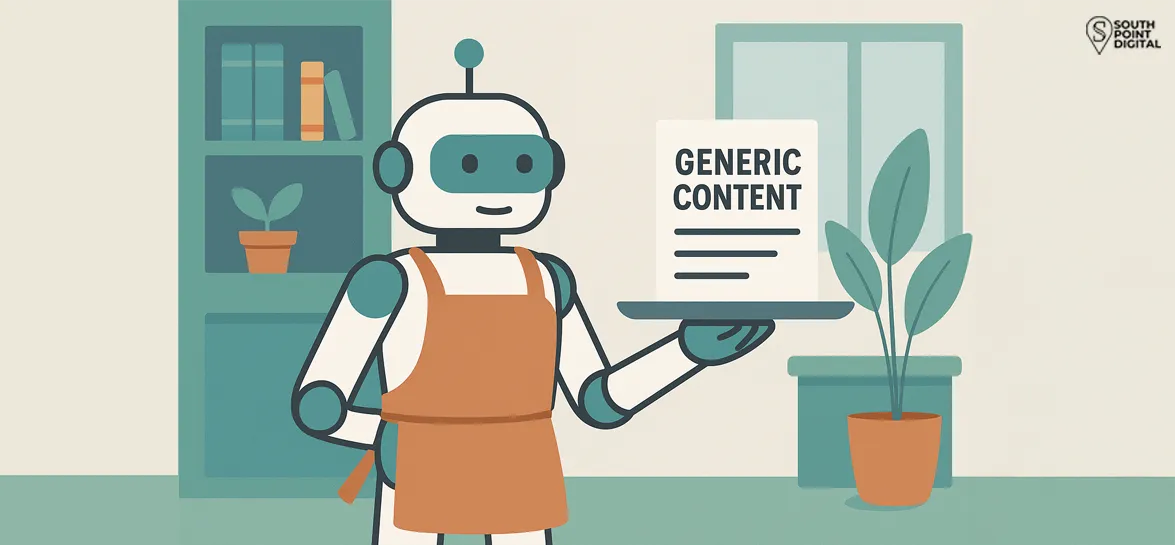AI Vs Human Content: What’s Better for SEO?

The AI vs Human content debate is a hot topic right now.
And a lot of small business owners are asking the same thing: Can I use AI to write my content?
The short answer? Yes. But the better question is: should you?
If your goal is to just fill space on your website, then AI will do the job. Fast and cheap.
But if you’re hoping for actual traffic, better rankings, and more leads (and we’re pretty sure you do), then the answer’s a little different.
What AI tools are good at
AI writing tools have come a long way in a short amount of time. You can give them a topic, and they’ll churn out 800 words that sound fine. For small tasks, that’s ok. Maybe even really useful.
Here’s where they tend to help:
- Outlining ideas
You can prompt a tool like ChatGPT or Jasper to create a rough blog structure. That’s helpful if you’re stuck. Instead of wondering what to write, you get a starting point. It might even spark some creativity for more ideas. - Summarising basic topics
If you’re writing about something straightforward, like how to book your services or what to expect from a consultation, AI can create the draft of it. - Tidying up your own writing
You can paste your draft into an AI editor to fix grammar, reword clunky sentences, or shorten sections.
None of these things replace you, though. They just save you some time.
The problem with AI generated blog content
When it comes to content that actually performs, the ones that that drive visits to your site, ranks well on Google, and builds trust, AI just doesn’t cut it.
And here’s why.
AI only gives you what you ask it
That might sound obvious, but it’s a big part of why the content often feels generic.
It doesn’t know your goals, your voice, or what your clients actually care about unless you spell it out.
That’s where GIGO comes in: Good Input, Good Output. (Or Garbage in, Garbage out in the computing world). If you feed it generic prompts, you’ll get generic content.
For example, asking it to write a blog post about “how to pick a good electrician” will give you something that could have come from anywhere. It could apply to literally anywhere in the world.
It might be technically accurate, but it likely won’t reflect how your business actually works or what makes your clients choose you. It skips over the quirks, the real questions people ask, and the local details that matter. Like local city laws, for example.
That kind of insight only comes from experience. As the business owner writing the post, you would know what details to skip and what to explain a bit more, because you’ve been through it yourself and know what sets your customers’ minds at ease. That’s what makes content actually helpful. And helpful content is what search engines strive to serve the person searching.

AI can sometimes get it wrong
Most of the AI writing tools you’re using today are known as LLMs, or Large Language Models.
Tools like ChatGPT, Claude, or Gemini all fall into this group. They don’t understand language the way people do. They don’t know facts, either. What they do is predict which word should come next based on patterns in the text they’ve been trained on.
That’s important. It means the AI isn’t pulling from a live database of verified facts. It’s working from a huge dataset made up of books, websites, and forums. Some of it useful, some of it outdated, and some of it just plain wrong. GIGO in action yet again.
For a service business, this matters. Your clients rely on you to know your stuff. And if the AI gets it slightly wrong and you don’t catch it, that can cause confusion. Or even worse, tank your reputation.
AI can’t show emotion
Most customers don’t make decisions just based on facts. They choose to work with you because they like how you make them feel. Because they like your “vibe”.
You can’t “vibe” with AI.
Sure, you could tell AI to try to sound friendly or excited, but what it produces still doesn’t feel completely natural.
Humans make decisions based on emotions. According to Gallup, 70% of our decisions are based on emotional factors. So if you’re not connecting with your customers on an emotional level, you’re losing out.
People are getting tired of AI content
You’ve probably noticed this. You’re scrolling on social media, and you hit a post that has that same AI voice. again. And before you even finish the first sentence, your thumb’s already moving. Scroll.
That’s called AI fatigue. And it’s happening with blog content too.
People are starting to recognise AI-written content the moment they see it. It’s showing up everywhere. And it all sounds the same.
Phrases like “leveraging insights”, “delve”,“crucial strategies” or “in today’s fast-paced world” are everywhere. It’s become such a well-known sign that even ChatGPT jokes about it on twitter.

And the more of it people see, the faster they scroll past.
The thing is, if you’re using content to build trust or get someone to click, call, or book a service, you don’t want to sound like everyone else. You want them to feel like there’s a real person behind the words. Someone with actual experience. Someone with a point of view.
That’s what builds trust.
Should I avoid using AI for my content?
Not at all. AI can be incredibly useful, especially if you’re short on time or stuck for ideas.
You can use it to build outlines, brainstorm topics, or get a rough first draft. The key is not to rely on it to do all the work.
Small business blog tips: Where AI can actually help
If you’re running a small business, your time is limited. And we’re all for using tools that help you get more done, quicker.
But when it comes to your content, you need to use it to help you, not replace you.
Let AI build a rough draft
Staring at a blank screen is no fun. And it can be tempting to just let AI do its thing and then copy, paste and publish.
But instead of letting AI write an entire bland, generic piece of content, let it help you get a rough outline instead. It might not be good enough to publish straight away, but it gives you something to edit.
If you need to write that blog post on “how to pick a good electrician,” start by asking AI for an outline with relevant headings. Then let it generate a draft.
Now rewrite the intro. Add your real advice. Cut the obvious filler content, and maybe include a local example or story if it’s relevant.
Suddenly, it sounds like you. That’s the part people care about.
Be specific
General blog posts don’t rank. Everyone’s written them. And you’re not going to win Google’s attention with another post about the same thing that is already overcrowding the interwebs.
Where you might win is by writing “how to pick a good electrician in Durbanville”. Mention your city. Your neighbourhood. Your actual process. Be clear about what makes your business different.
Publish regularly
Search engines prefer websites that update content often. You don’t need to write daily, but once or twice a month makes a big difference. Instead of 10 rushed posts, focus on two useful ones. Make them better than what’s already out there.
Does AI generated content affect SEO? It depends.
Google has made it clear that it doesn’t matter if your content is written by AI or not. What it cares about is whether the content is actually helpful.
If the content is useful, relevant, and written to help people, not just to rank for keywords, Google will treat it like any other content.
The problem is, AI content often ends up sounding vague or saying the exact same things everyone else is saying.
If you don’t fix that before publishing, it can hurt your rankings. Googles places a large emphasis on quality and trust. So even if you use AI to help write something, it still needs your input to feel real and be worth reading.
Resource: Are Keywords and SEO the same thing?
AI Vs human content: which one is best?
If you care about rankings and organic traffic, human content still wins. It’s more relatable, more trustworthy and more likely to connect with readers. AI might catch up eventually. But right now, it’s still not good enough on its own.
That doesn’t mean ignore it. On the contrary, we encourage the use of AI to help you speed things up. Just make sure a real person does the final edit. If that’s not you, then someone who understands your customers and your voice.

